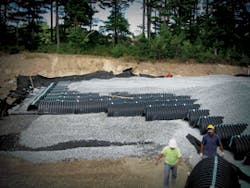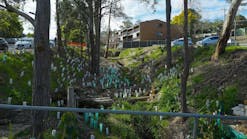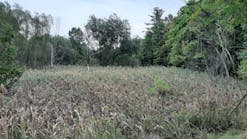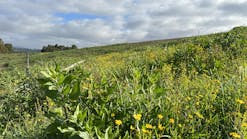Alpharetta, GA, lies at the northern edge of the metropolitan Atlanta area and is the home to a beautiful environmental park known as Rock Mill Park.
“It’s basically a BMP demonstration site,” says Michael Breedlove of Breedlove Land Planning Inc. in Conyers, GA. “We had the opportunity to work with Dr. Richard Warner with Kentucky Surface Mining Institute at the University of Kentucky and with another professor from Georgia Tech.”
The park was built with a seep berm, constructed wetlands and bioswales, and a variety of other best management practices (BMPs).
Breedlove’s work with seep berms goes back some 10 years, when he worked on another BMP demonstration site for the Georgia State Legislature at Big Creek Elementary School in Fulton County. “Dr. Warner at that time was working hand-in-glove with our office on the 25- to 27-acre elementary school site. He really wanted to try to do a project without silt fence, utilizing the seep berms, trying to break the paradigm of silt fences being the be-all-end-all to perimeter control,” according to Breedlove.
The Seep Berm Design Manual, produced by Warner and colleagues, explains the term. “The primary function of a seep berm is to retain sediment-laden runoff. A seep berm is a linear sedimentation control constructed as an earthen berm perpendicular to the direction of runoff. It stores sediment and releases runoff at a low flow rate through pipe outlets spaced at equal intervals along the length of the berm. The primary components of a seep berm are the earthen berm and outlet pipes. Check dams spaced perpendicular to the seep berm are recommended to reduce the quantity of sediment and water that could be discharged if a break occurs along the seep berm. To enhance performance, a seep berm is best utilized in conjunction with a vegetated filter strip or riparian zone immediately down gradient of the berm.”
Such a combination seep berm-riparian zone treatment system was built at the Big Creek site. Warner also notes, “Erosion controls such as excelsior or coconut mats are recommended to stabilize the seep berm and enhance grass growth in case there is an overflow of the berm due to a large storm, greater than the 2-year, 24-hour design storm.”
Warner lists a number of advantages to using a seep berm instead of the more common silt fence or sediment basin:
- Enables complete storage of the most frequent storm events
- Attenuates peak flow
- Infiltrates stored runoff, thereby increasing groundwater recharge
- Provides multiple sedimentation chambers with the use of check dams
- Provides a linear control, allowing for a greater portion of land development compared to sediment ponds
- Provides excellent reduction in effluent sediment concentration
A typical use of a seep berm is to control sediment-laden runoff from construction sites. Breedlove explains, “The seep berm is basically just a methodology for trying to mimic the original hydraulic conditions of the site, dissipating the pollutants infiltrating the stormwater. You’re having to work with the site contours, and on some projects you can do this, and some you can’t.”
At the Big Creek site, he says, “Running parallel with this walking trail seep berm, every 40 to 50 feet, we would have intermediate checks that allowed the water to be captured. It had turf reinforcement mats in a depression, where it would simply flow from one chamber to the next chamber to the next chamber. It was a system train for treating stormwater. It eventually led to a storm-drainage system that led to a central stormwater-management basin. So you treated the stormwater as many times as possible.”
At the more recent Alpharetta Rock Mill Park site, a seep berm was employed along with a variety of other BMPs. “It was a system to treat pollutants from the paved areas before they were returned to the riparian buffers,” according to Breedlove.
“That project was a demonstration situation, where, for example, there was a sample green roof, and there were bioswales. It led from one BMP to another, overflowing into the next, creating that bioretention system train, both post-construction and during construction.”
The Rock Mill Park seep berm was 90 feet long and 2.5 feet high, with 1-inch PVC outlet pipes placed at 2 feet above the channel bottom and spaced every 10 feet along the length of the seep berm. During the construction period at the park, in July and August 2007, there were five storms, four of which had rainfall of either just under or just over one inch, with the majority of the rain falling within the first 30 to 60 minutes. These rainfall events were described as “typical high-intensity, short-duration summer thunderstorms,” and the result was that “zero sediment-laden runoff was released for the entire construction period,” according to the Seep Berm Design Manual.
The purpose of the demonstration sites was to show the state legislature how various new and innovative BMPs work, and the type of results that can be attained with them. In addition to the seep berm, Breedlove says, the site also included SiltSaver domes, coir logs, and other inlet-protection BMPs.
He notes that one of his major concerns is the sometime “disconnect” between concern for temporary during-construction BMPs and for permanent post-construction devices.
But, he says, “I think that things are changing. What you’re seeing is that with the LEED [Leadership in Energy and Environmental Design] movement, people are getting much more attuned to the post-construction BMPs of bioretention swales. Milton High School in Alpharetta is a great example of the bioretention swales and the disconnection of the impervious areas in that parking lot in front of the school. Everything keeps flowing into the bioretention swales, being filtered through those areas before it’s released back into the riparian buffers.“With bioretention swales, what we try to do is sheet-flow the impervious areas into the swales,” he adds. “Basically, what you’re trying to do is break up the huge parking lots and disconnect that impervious cover and run it through the swales, to infiltrate through an enhanced medium into a drain that picks it up and takes it out. Inside those bioretention swales there is a storm structure that stands up a little taller than the bottom of the basin. Once it reaches a certain point, 6 to 12 inches deep, it will overtop that structure and get out into the stormwater management basin.”
Rock Mill Park contains a number of low-impact development (LID) techniques, including native plantings and a green-roof pavilion, and in 2008 it was awarded the title of Georgia Water Resources Project of Excellence.
Warehouse Expansion on a Tight Timetable
Reinhart FoodService is the third-largest privately held foodservice distributor in the US, delivering more than 100 million cases of product to over 35,000 customers each year, including restaurants, schools, hotels, nursing homes, and hospitals.
Its Natco subsidiary, based in New Bedford, MA, obtained some large new contracts from restaurant chains and needed to expand. Emerald Excavating operations manager Sheamus Kelleher explains some of the issues. “They had to add on to their food warehouse,” Kelleher says. “The addition to their facility was 27,600 square feet, and the addition is located in a place where they had a parking lot on the side of their building. In the front of the facility, they had a large detention pond. They not only had to replace that parking area that was being taken up by the new addition, but they had to add some parking, because they were adding square footage to their facility.
“The only space they had available to add parking was in the current location of the detention pond, so the detention pond had to be filled in, and they could no longer mitigate stormwater flows with that detention pond. They had to come up with some other solution.
“They were also adding impervious areas to the site, such as the parking lot addition, so the stormwater management requirements for the site were actually increasing. What the engineer came up with, and it was really the only solution he could come up with, was underground stormwater detention.”
Kelleher explains that the company opted to install a Cultec stormwater chamber, which proved ideal for this project.
“The soils in the area were not conducive to leaching; they were a fine-grade soil. It truly is a detention facility as opposed to a retention facility. They do get some infiltration, but I don’t believe the engineer counted on that.
“The water table was essentially right at the bottom of the Cultec system. Basically, we needed a low-profile system. Because of the fact that we were also impacted by the elevations of the current system-where the inlets for the drainage system were taking roof drainage from the existing building-and because of how far they had to move the water through the pipe system, we ended up pretty deep as it is. So we needed a somewhat low-profile leaching area, and the Cultec system worked really well for that.”
The system was installed in September 2009. “The other part that was difficult in the construction was that, because of the same space limitations that led to putting in the underground system, the whole facility had to stay open during the construction,” he notes. “They had trucks coming in all the time. There’s a main access road at one side of the site, and it was very close to where we were putting this system in. So we had to be able to put in part of the system, and then we flip-flopped material and built the other half. Using the Cultec system, it comes together so quickly, and it’s so easy to handle, we were able to do that in a short time frame, and we were able to manage the construction very easily. It worked out really well. I believe we did the whole thing in a week and a half.
“One of the things that was nice about the Cultec system is that we have some Caterpillar track-type skid-steers, which are low ground pressure. With that heavy-duty Cultec system, as your laborers are installing it, you have to put stone in and around it. The system is very large, so from the edges you cannot reach the middle of the system with an excavator. With the strength of the Cultec unit, you can start putting stone over the top of it from one side, and you can literally drive over the top of it with a skid-steer. That was very convenient-it saved us so much time. I don’t know that you can do that with some of the other systems.”
Kelleher says that to control stormwater runoff during construction, “We used hay bales and silt fence down at the outlet, and we used stone check dams. In the existing catch basins, which ultimately fed water into the system, we used Silt Sacks to clean the water coming into the catch basins.”
He would recommend the Cultec system for other locations, he says. “From a constructibility standpoint, because of the time that you save in actually building the system, I think it is very cost-effective. The biggest constraint on this project was time. Because of the fact that it was a facility that they were trying to continue working in, they had a very, very tight, compressed project schedule for this. Because of the size of the Cultec system, it was a major impact on the site and the area. It was important to be able to get it done quickly so that the foundations for the building could get in, and then they could start building the structure. If it was a different type of system that was more difficult to install, it would have really impacted the overall schedule of the job.”
Kelleher says the system doesn’t require ongoing maintenance, “but there are several inspection ports. You have a pipe that is connected down through the top of them, and there is a frame and cover in the parking lot. You can open it up, and an inspector can come and look down into the system and make sure it isn’t filling up with dirt, and they can tell how much water is in it at any given time. I’m sure that they probably will look at that periodically. As long as they use catch basins with sumps in them, as long as they keep sediment from getting into it, it shouldn’t have any issues.”
Searching for a Better Mousetrap
John Moss, director of project management for Texas-based Construction EcoServices, explains, “We are a turnkey stormwater quality and stormwater management company. Our focus at the very beginning was in stormwater pollution prevention compliance, meaning that we focused, and still do, on general contracting commercial work. We don’t do home building projects per se, but we are a subcontractor to general contractors in the commercial space, in the Houston, Austin, and San Antonio areas in Texas.”
Although the company typically has between 200 and 300 active projects, the scope of its work is very specialized, Moss says. “It’s highly regulated, it’s highly enforced, at least in many areas, and it’s the kind of work that these contractors feel they need uniformity with, in terms of compliance with environmental laws relative to stormwater across all their projects.”
Emerging technologies are critical to the business, he says: “better ways to do these things in the construction phase, construction best management practices such as inlet protection, flow controls, perimeter controls, and so on. We are constantly searching for a better mousetrap.” A higher level of compliance at a lower cost is what the company ultimately wants to provide to its clients.
“One of the early things, years ago, we found for area inlet protection was a product known as Silt Sack. We’ve done lots and lots of business with ACF Environmental over the years. They are our exclusive supplier for certain products, both the Silt Sack and the Gutter Gator for curb inlet protection, and various versions of these products, as well as Erosion Eels.
“It’s interesting to step back and look at the history of stormwater compliance as it pertains to BMPs on construction sites,” he adds. “It has evolved dramatically, but for many engineers, the reality is that it is not their business to really find this kind of stuff. They tend to stick with old methods of doing things. A lot of it comes from their library of cut-and-paste specs that they put into a SWPPP [stormwater pollution prevention plan]. That may include hay bale barriers, rock filter dams, or sandbags at inlets, and various other ways of doing things.”
A recent project that allowed Construction EcoServices to utilize a variety of newer technologies was stormwater work at Avondale House, a Houston facility providing day activities and residential services for children with conditions on the autism spectrum.
“What we were doing was trying to value-engineer the solution for Avondale House,” says Moss. “This site had a detention requirement, but the size of the property indicated that if they built an open pond, it would take up too much parking and other space. So we had to come up with an underground detention solution.
“We designed and installed 20,500 cubic feet of underground detention using a product called RainTank. The product that feeds that inlet, that cleans the water before it gets to the RainTank, is a Grate Inlet Skimmer Basket.”
Moss says that HDPE pipe had been considered for the site, but because of its cost and footprint, RainTank was a better solution. He describes the process:
“You dig the hole with an excavator, and once the footprint is defined, you only need about 24 inches on all sides. You level and compact the base, then you install the nonwoven geotextile fabric, which lines the hole. Then you assemble RainTank and stack it in the hole. Once that’s done, the geotextile fabric is wrapped around it, then we compact in 12 to 18 inches all the way around the hole, put a geogrid on the top, and then raise the level to grade.”
Because the system is modular, he says, no heavy equipment is required, unlike pipe-system installation. “It’s literally assembled onsite, and with manpower,” he says.
One of the challenges Moss faced was engineering the RainTank around existing utility pipes. “The flexibility of RainTank was extremely helpful in that regard,” he says. “With a pipe system, there’s not a lot of flexibility there; the pipe is what it is. But with RainTank and its modular characteristics, it was able to fit around existing utilities, and to meet the footprint requirement.”
He also notes that the system typically doesn’t need much maintenance. “There are portals built into the system to allow for cleanout if necessary, but it’s the pretreatment to the RainTank that keeps that from being a maintenance problem.”
For control of runoff during the construction phase, Moss utilized standard silt fence for perimeter protection, Gutter Gator for curb inlet protection, and Silt Sack for area inlet protection.
Green and Clean
The small picturesque town of Sequim, WA, lies at the northern end of the Olympic Peninsula, in the extreme northwest corner of the continental US. The local Jamestown S’Klallam Tribe was in the process of building its new Longhouse Market and Deli there, and it was important to incorporate low-impact development (LID) techniques into the project.
The market is located in close proximity to two environ-mentally sensitive areas: the Jimmycomelately Creek estuary and the tribe’s geoduck clam bed in Sequim Bay. The tribe recognized that stormwater treatment was paramount in protecting these crucial waterways and felt that incorporating LID stormwater solutions would offer the best solution to the immediate challenges.
One problem the tribe faced was its desire to maximize parking spaces for the market while still meeting the high environmental standards required by the Washington Department of Ecology. Soils at the site were not conducive to infiltration, and a high groundwater level limited the options for using LID designs.
The Filterra Bioretention System provided a solution to the site constraint and infiltration challenges. Two of the units were built, providing efficient pollutant removal within a small space. Each unit consists of a belowground precast concrete container with specially engineered filter media, and a tree or shrub is planted in each unit. The units remove bacteria, metals, total suspended solids, and nutrients from stormwater runoff. This allowed the tribe to maintain excellent waterway protection, and the small footprint of the Filterra units allowed maximum use of the available land for customer parking.
The parking lot runoff was effectively treated upstream, removing stormwater pollutants at the source, with the compact “green” bioretention systems that incorporated local trees and that involve easy follow-up maintenance.






